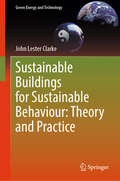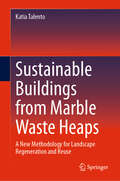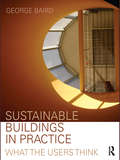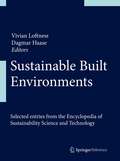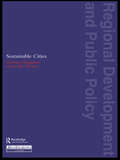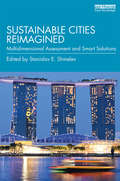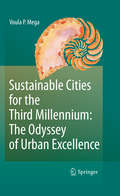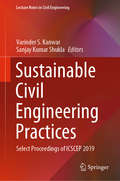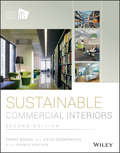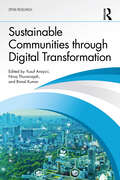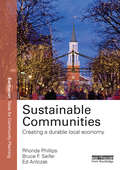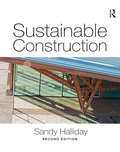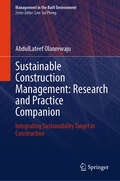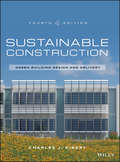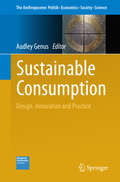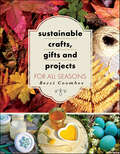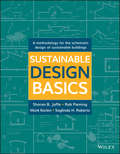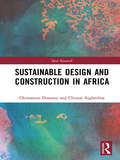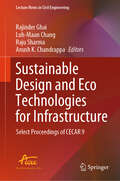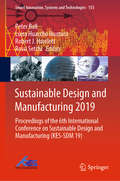- Table View
- List View
Sustainable Buildings for Sustainable Behaviour: Theory and Practice (Green Energy and Technology)
by John Lester ClarkeThis book is about where theory meets practice in the realm of sustainable architecture. The book reveals how to create buildings that not only minimize environmental impact but also help shape sustainable behaviour. Including a literature review, comprehensive online surveys, and analysis of real projects, the book presents a narrative that blends theory with tangible examples. It includes illustrated case studies that breathe life into five exemplary sustainable buildings, showcasing their impact. The book demonstrates the potential of architecture to realise a sustainable future. It shows how construction can help build a more sustainable world.
Sustainable Buildings from Marble Waste Heaps: A New Methodology for Landscape Regeneration and Reuse
by Katia TalentoThis book examines how discarded marble heaps can be repurposed, in situ, to breathe new life into the landscape, offering solutions that are as innovative as they are practical and sustainable. The author showcases the power of creativity and sustainability to revitalize communities and landscapes with new architectural buildings and public spaces. The volume combines theory with practice, including an extensive bibliography about landscape mutation, rehabilitation of quarries and waste reuse, and, at the same time, a detailed case study on the Estremoz Anticline, in Portugal, one of the world’s main sites of marble extraction. Of all the material extracted from the several quarries of the Estremoz Anticline, only about 9% is marketed because of assessed of quality standards. Distinct from other research volumes in this domain, “Sustainable Buildings from Marble Waste Heaps” focuses on the regeneration of industrial landscapes through the on-site reuse of waste heaps, without removing the material from the context it belongs to or changing its morphology, preserving the identity of the place and promoting circular economy.
Sustainable Buildings in Practice: What the Users Think
by George BairdCurrent assessment methods of sustainable buildings do not adequately account for the users’ needs. Given that over the life of a building, total salary costs far outweigh both operating costs and combined capital and rental costs, the occupants’ needs are not something which should be sensibly ignored. This book presents an unbiased evaluation of thirty of the most cutting-edge, sustainable buildings in the world, in terms of the users’ perceived comfort, health and productivity. The author has visited the buildings, interviewed the design teams and examined the findings of a sixty-question standardized user questionnaire. The book provides: thirty case studies covering mixed-mode, passive and environmentally sustainable commercial and institutional buildings detailed insights into the principles underlying the design of sustainable buildings worldwide, over several climatic zones and eleven countries, together with clear explanations and illustrations of innovative design practice a discussion of common issues and the lessons that may be learnt from a study of the performance of sustainable buildings in practice, from the point of view of the people who use them. This important book will be of great benefit to architects and engineers, facility managers of commercial and institutional buildings, as well as developers and researchers, academics and students in these fields.
Sustainable Built Environments
by Vivian Loftness Dagmar HaaseSustainable design is a collective process whereby the built environment achieves unprecedented levels of ecological balance through new and retrofit construction, with the goal of long-term viability and humanization of architecture. Focusing on the environmental context, sustainable design merges the natural, minimum resource conditioning solutions of the past (daylight, solar heat, and natural ventilation) with the innovative technologies of the present. The desired result is an integrated "intelligent" system that supports individual control with expert negotiation for resource consciousness. International experts in the field address the fundamental questions of sustainable design and landscape management: How should the sustainability of landscapes and buildings be evaluated? Which targets have to be set and which thresholds should not be exceeded? What forms of planning and governance structures exist and to what extent do they further the goals of sustainability? Gathering 30 peer-reviewed entries from the Encyclopedia of Sustainability Science and Technology, Sustainable Built Environments provides comprehensive, multidisciplinary coverage of these issues and other aspects of sustainable building and landscape design.
Sustainable Cities (Regions and Cities #No.7)
by Graham Haughton Colin HunterSustainable Cities simultaneously tackles two issues of immediate public concern which also find themselves high on the policy agenda: sustainable environmental development and urban development. The themes of the book - the bringing together of the insights of environmental science, the social sciences and management; the combination of problem analysis with practical application; and a critique of urban environmental problems concentrating on air and water pollution - are illustrated throughout with in-depth material and case studies taken from around the world and are approached from a variety of perspectives: economic, ecological and managerial. Each chapter has a concluding section pointing to key concepts, key reading and a range of discussion points.
Sustainable Cities Reimagined: Multidimensional Assessment and Smart Solutions
by Stanislav ShmelevTo assess urban sustainability performance, this book explores several clusters of cities, including megacities, cities of the Global South, European and North American cities, cities of the Middle East and North Africa, cities of Central and South East Asia, a city state of Singapore and a large group of global cities. It applies a multi-criteria approach using a panel of environmental, economic, social and smart indicators to assess progress and policies in global cities including London, New York, Hong Kong, San Francisco, Los Angeles, São Paolo, Rio de Janeiro, Buenos Aires, Paris, Berlin, Stockholm, Moscow, Beijing, Seoul, Singapore, Shanghai, Sydney, Tokyo and many others. Additional attention is given to the issues of climate change, poverty and smart dimensions, with renewable energy and the drivers of urban CO2 emissions playing the central role. This book is abundant with case studies considering strategies, policies and performance of the leading cities, including San Francisco, Stockholm and Seoul in greater depth, exploring how their successes can be used by other cities. The book identifies key linkages between different smart and sustainability dimensions as well as investment opportunities in cities with sustainability potential. This book will be of great interest to policy makers, city and regional authorities as well as scholars and students of urban planning and sustainable development aiming to facilitate a sustainability transition in our cities around the world.
Sustainable Cities for the Third Millennium: The Odyssey of Urban Excellence
by Voula P. MegaThis book offers a 360 degree view of the challenges facing cities at the dawn of the millennium in terms of growth, governance, institutions and infrastructures, environmental well-being, social integration, science, culture and the arts, urban renaissance and planning, local democracy and citizenship. One year afte the crisis that started in 2008, the book presents responses to overcome the crisis of values and engage in a sustainability path from European and world cities.
Sustainable Cities: Pioneering Approaches to Green Urbanism and Climate Resilience (Advances in Science, Technology & Innovation)
by Simon Elias Bibri Giuseppe Resta Dorina Papa Dina MagnayeThe book studies specific aspects of urban planning and environmental management, aiming to provide actionable insights and solutions. This book opens with an analysis of urban processes and the development of mass housing estates, using Famagusta, Cyprus, as a case study. It highlights how topographical factors influence urban growth and housing patterns, providing important implications for infrastructure planning. A significant focus is placed on the development of environmentally-friendly building materials. Several chapters explore the use of waste products, such as cork, in creating sustainable materials. Green and blue infrastructure also receive substantial attention. The book addresses strategies for integrating these elements into urban environments to combat climate change. Topics such as the retention capacity of green roofs and the role of vegetation in improving urban air quality underscore the importance of ecological infrastructure in creating resilient cities. The book further studies urban climate and pollution analysis, presenting advanced methods for monitoring and managing environmental conditions. Chapters on climate change monitoring, air pollution assessment through bryophytes, and VOCs monitoring provide tools for understanding and addressing urban environmental challenges. Human-centric design is another key theme, with discussions on pedestrian comfort and walkability in urban spaces. By focusing on outdoor promenades and thermal comfort, the book highlights the need for urban designs that enhance the quality of life for residents. Practical approaches to project management and planning are also covered. The book introduces methodologies such as PERT/CPM and Monte Carlo simulation techniques for improving project outcomes and developing criteria for climate-friendly planning competitions. Finally, the preservation of landscape heritage amidst urban expansion is explored. A methodology for creating a landscape catalog in Arequipa, Peru, is presented as a way to balance development with the conservation of cultural and natural landscapes.
Sustainable Civil Engineering Practices: Select Proceedings of ICSCEP 2019 (Lecture Notes in Civil Engineering #72)
by Sanjay Kumar Shukla Varinder S. KanwarThis book comprises select proceedings of the International Conference on Sustainable Civil Engineering Practices (ICSCEP 2019). It covers several important aspects of sustainable civil engineering practices dealing with effective waste and material management, natural resources, industrial products, energy, food, transportation and shelter, while conserving and protecting the environmental quality and the natural resource base essential for future development. The book also discusses engineering solutions to sustainable development and green design issues. Special emphasis is given on qualitative guidelines for generation, treatment, handling, transport, disposal and recycling of wastes. The book is intended as a practice-oriented reference guide for researchers and practitioners, and will be useful for all working in sustainable civil engineering related fields.
Sustainable Collective Housing: Policy and Practice for Multi-family Dwellings
by Lee Ann NicolHousing stocks provide much more than just shelter. Energy suppliers, pension fund managers and public transit providers are but a few of the many stakeholders that have a regulated interest in the non-shelter goods and services offered by housing. Such stakeholders and their activities are traditionally addressed on a sectoral basis, yet regulations that are designed to apply to one often have unintended effects on another, effects that may produce negative pressure on the housing stock – and the wider built environment – in terms of sustainability. Sustainable Collective Housing presents a new and comprehensive approach to the study of the regulations pertaining to housing: the institutional regimes framework. By considering the housing stock as a resource, this framework enables the ensemble of public policies, property rights and contracts that govern all shelter and non-shelter uses of housing to be identified, analyzed and evaluated. Using examples from Switzerland, Germany and Spain, this book describes the regulatory conditions that must be in place before housing sustainability issues can be effectively tackled. The book will provide policy-makers, housing stock owners and other stakeholders with the knowledge and tools to make rational and legitimate decisions regarding housing sustainability.
Sustainable Commercial Interiors
by Penny Bonda Katie SosnowchikDiscover new approaches to green design and sustainable building with this comprehensive guide There's a substantial amount of information designers and architects need to understand about sustainability and commercial projects, especially as expectations for professionals in the industry become clearer. Luckily, the second edition of Sustainable Commercial Interiors has been revamped to serve as a comprehensive guide for anyone looking to understand the latest in green and sustainable design. Fully revised throughout, this resource now includes frameworks based on the new LEED v4 rating system, and provides fifteen brand-new case studies that document green design and building strategies for all types of projects. You'll find information on materials, furnishings, finishes, product standards, and certifications, all designed to keep you in the know and prepare you for future ventures in sustainable design. The ideal professional companion for interior designers, commercial builders and developers, architects, and interior design students, this guide is an all-in-one introduction to the most essential topics in the industry, such as global environmental issues, water and energy usage, and the tools of the trade, to name just a few. The book is illustrated with full color images throughout. Fully revised and updated to include information on the new LEED v4 rating system Discusses the past, present, and future of sustainable design Considers global environmental issues, such as waste, land use, and bio-inspired design Covers water and energy usage and sustainable materials Discover the benefits of green building and adopt new approaches to sustainable design. Sustainable Commercial Interiors is your go-to resource for navigating new expectations for responsible interior design.
Sustainable Communities in Europe
by William M LaffertyA presentation of detailed comparative research into the implementation in 11 European countries of Local Agenda 21 - the action plan for sustainable development at community level. Overviews of implementation in each country are accompanied by analysis of positive and negative changes, as well as a comparative analysis with high academic and policy relevance. Numerous practical examples are included of best cases and crucial barriers.
Sustainable Communities through Digital Transformation (Spon Research)
by Yusuf Arayici Niraj Thurairajah Bimal KumarThis book brings together cutting-edge exploratory research findings to show how a vision for sustainable communities can be enabled by digital transformation. It attempts to apply existing knowledge about digital transformation and sustainable communities and compare, interpret, diagnose, and evaluate a variety of digital solutions to ascertain their suitability for the delivery of a more sustainable built environment. Chapters examine a breadth of issues including how digital transformations could: Provide digital/physical working/living environments that anticipate emerging lifestyles Blend digital engagements into the physical engagements within the built environment Support business and social activity in physical and online venues Use advanced information and community-oriented technologies for efficient management of urban services Promote sustainability Express narratives that celebrate the experience of place and community Leverage transformation of educational systems Foster linkages between universities, and between universities and businesses Facilitate working relationships among small and large companies Foster new processes and arrangements for innovation in the built environment By comparing the key principles of digital transformation with those of sustainable communities, the contributors seek to justify or discount the applicability of digital change for achieving more sustainable communities. The research presented in this book is essential reading for architecture, urban planning, quantity surveying, building surveying, real estate, and construction management professionals and academics.
Sustainable Communities: Creating a Durable Local Economy (Earthscan Tools for Community Planning)
by Rhonda Phillips Bruce Seifer Ed AntczakWith a foreword written by Senator Bernie Sanders What is a durable economy? It is one that not only survives but thrives. How is it created, and what does it take to sustain over time? Sustainable Communities provides insight and answers to these questions. Citing Burlington, Vermont's remarkable rise to award-winning status, this book explores the balance of community planning, social enterprise development, energy and environment, food systems and cultural well-being. Aimed at policymakers, development practitioners, students, and citizens, this book describes which and how multiple influences facilitate the creation of a local, durable and truly sustainable economy. The authors hope to inspire others by sharing this story of what can be done in the name of community economic development.
Sustainable Construction
by João M. P. Q. DelgadoThis book presents acollection of recent research works that highlight best practice solutions,case studies and practical advice on the implementation of sustainableconstruction techniques. It includes a set of new developments in the field ofbuilding performance simulation, building sustainability assessment,sustainable management, asset and maintenance management and service-life prediction. Accordingly, the book will appeal to a broad readership of professionals,scientists, students, practitioners, lecturers and other interested parties.
Sustainable Construction
by Sandy HallidayThe second edition of Sustainable Construction provides a masterclass on the principles and techniques involved in the design and delivery of practical, affordable, high quality sustainable buildings and places. It presents precedents, theory, concepts and principles alongside 120 wide ranging case studies that highlight current best practice and encourage implementation. Topics in the book include: • the history of ideas in sustainable construction • policy • materials • cost issues • appraisal techniques • environmental design • energy • water • construction processes • and urban ecology. The book is heavily illustrated in full colour and is an ideal, contemporary, accessible primer to courses in Architecture, Construction, Building Engineering, Environmental Engineering, Project Management, Landscape, Urbanism and Development.
Sustainable Construction Management: Integrating Sustainability Target in Construction (Management in the Built Environment)
by AbdulLateef OlanrewajuThis book provides a centralized source of information on specific sustainable construction management strategies, practices, and principles. It compiles pertinent information on sustainable construction management into a single, easily accessible document together with guidelines, procedures, and best practices. Without having to examine several sources, users may easily access the information they require for sustainable construction management. This book blatantly seeks to standardize procedures, enable onboarding and training, guarantee compliance, offer reference and troubleshooting assistance, encourage openness and communication, and promote ongoing process and organizational improvement. The book contains practical insights and trends drawing from empirical conclusions that are derived from data collected from experts and practitioners in the construction sector. Potential readers could include instructors at tertiary institutions, students (both research, graduate, and undergraduate students) as well as policy-makers from the relevant authorities who seek to better understand sustainability in the built environment.
Sustainable Construction in the Era of the Fourth Industrial Revolution (Routledge Research Collections for Construction in Developing Countries)
by Clinton Aigbavboa Wellington Didibhuku Thwala Ayodeji Oke Stephen SegunThis book provides readers with an understanding of various concepts, benefits, and practices that the adoption of Fourth Industrial Revolution (4IR) technolo>gies can bring when working towards sustainable construction goals. As digitalization continues to advance rapidly, the pressures on stakeholders in the architecture, engineering, construction, and operation (AECO) industry to revamp and restructure their activities and outputs become increasingly prev>alent. This research book explains the importance of various digital tools and principles to achieve sustainable construction projects. It adopts various stand>ards and concepts to highlight how 4IR technologies could assist and accelerate construction sustainability. It is the first book to link construction management with various digital tools to enhance construction projects’ sustainability. It also provides an in-depth insight into the concept of sustainable construction 4.0 across both developing and developed countries for construction professionals, sustainability experts, researchers, educators, and other stakeholders.The book can be adopted as a research guide, framework, and reference on sustainable construction, the concept of sustainable projects, digitalization in the construction industry, and the 4IR.
Sustainable Construction: Green Building Design and Delivery
by Charles J. KibertThe leading green building reference, updated with the latest advances in the field Sustainable Construction is the leading reference for the design, construction, and operation of high performance green buildings. With broad coverage including architecture, engineering, and construction, this book nevertheless delivers detailed information on all aspects of the green building process, from materials selection to building systems and more. This new fourth edition has been updated to reflect the latest codes and standards, including LEED v4, and includes new coverage of carbon accounting. The discussion has been updated to align with the current thinking on economics, climate change, net zero buildings, and more, with contributions by leaders in the field that illustrate the most recent shifts in thinking and practice. Ancillary materials including an instructor's manual and PowerPoint presentations for each chapter help bring this clear and up-to-date information into the classroom, making this book a valuable reference for working construction professionals. Also, Interactive graphics found throughout the course help activate the content and highlight key concepts for students. Sustainable construction has gone mainstream, and will one day be the industry norm. This book provides a comprehensive reference to all aspects of a project to show you how green building concepts and principles apply throughout the design and construction process. Get up to date on the latest green building codes and standards Learn about the newest technology in green building materials Adopt the best practices in procurement and delivery systems Apply sustainability concepts to all aspects of construction and design Green buildings operate at a very high level of efficiency, which is made possible only by careful consideration every step of the way. Appropriate land use, landscaping, construction materials, siting, water use, and more all play a role in a structure's ultimate carbon footprint. Sustainable Construction provides clear guidance for all aspects of green building, including the most recent advances and the latest technology.
Sustainable Consumption
by Audley GenusThis book originates from the work of contributors to initiatives and global networks promoting and pursuing lines of enquiry that recognise and probe relationships between sustainable consumption, design and production, and the implications of those relationships for new economic activity and the way we live and govern ourselves. It features contributions from social scientists (e. g. from the fields of innovation studies, geography, environmental policy and sociology) and practitioners, serving to generate a short-list of research perspectives and topics around which future research and actions in practice will be orientated. The book consists of ten chapters divided into three parts, focusing on: perspectives/methodological insights; empirical work integrating consumption and production; and site-specific practitioner-oriented case studies. The conclusion examines the key aspects of policy, research and practical implications.
Sustainable Crafts, Gifts and Projects for All Seasons
by Becci Coombes"The photo illustrations are easy to follow and Coombes provides plenty of useful tips...This will help crafters get in the spirit of any season." — Publishers Weekly Take advantage of nature’s bounty and craft in time with the seasons! Whether potting up dandelion honey, cooking and crafting with rose petals or preserving autumn leaves and acorns, there are so many wonderful gifts, ornaments and treats that can be made from either a short walk in the woods or a rummage in your cupboard. With an emphasis on foraging and upcycling, Becci explores the ways we can create beautiful projects using materials readily available in the garden and home. Upcycled projects include gorgeous home textiles woven from bed linen, mini lampshade fairy lights for a summer’s evening and even a fabulous picnic table from an old suitcase. Capture the breeze of autumn with wind chimes made from old necklaces and cutlery and learn how to felt old sweaters, turning them into cosy wreaths, brooches and purses for winter. There is also a section on working with willow, with projects encompassing everything from woven bird-feeders (with home-made fat balls!) to festive ornaments.
Sustainable Design Basics
by Mark Karlen Rob Fleming Sharon B. Jaffe Saglinda H. RobertsAn accessible, climate-diverse guide that transforms readers from sustainable design novices to whole-solution problem solvers. Sustainable Design Basics is a student-friendly introduction to a holistic and integral view of sustainable design. Comprehensive in scope, this textbook presents basic technical information, sustainability strategies, and a practical, step-by-step approach for sustainable building projects. Clear and relatable chapters illustrate how to identify the factors that reduce energy use, solve specific sustainable design problems, develop holistic design solutions, and address the social and cultural aspects of sustainable design. Requiring no prior knowledge of the subject, the text’s easy-to-follow methodology leads readers through the fundamental sustainable design principles for the built environment. Sustainably-constructed and maintained buildings protect the health and improve the productivity of their occupants, as well as help to restore the global ecosystem. The authors, leading practitioners and educators in sustainable design, have created a resource that provides a solid introduction to broad level sustainability thinking that students can take forward into their professional practice. Topics include space planning for sustainable design, integrative and collaborative design, standards and rating systems, real-world strategies to conserve energy and resources through leveraging renewable natural resources and innovative construction techniques and their impact on our environment. Usable and useful both in and beyond the classroom, this book: Covers building location strategies, building envelopes and structures, integration of passive and active systems, green materials, and project presentation Examines cultural factors, social equity, ecological systems, and aesthetics Provides diverse student exercises that vary by climate, geography, setting, perspective, and typology Features a companion website containing videos for each sustainable strategy, matrices, templates, Sketch-Up and AutoCAD files, PowerPoint slides, and extensive instructor resources Sustainable Design Basics is an important resource aimed at undergraduate architecture and interior design students, or first-year graduate students, as well as design professionals wishing to integrate sustainable design knowledge and techniques into their practice.
Sustainable Design and Construction in Africa: A System Dynamics Approach (Spon Research)
by Clinton Aigbavboa Oluwaseun DosumuThis book addresses some of the countless challenges faced by developing countries when adopting sustainable design and construction and offers suggestions for the way forward for African development projects. The authors argue that the pervasive non-consideration of the interrelationship between the elements of sustainable design and construction is the reason for the current failures in sustainable design and construction in developed countries. By treating sustainability as a complex system, the authors provide the missing link between the design and construction of projects in a sustainable way with a view to improving industry and project performance. In doing so the book posits the need for improved sustainability practice in developing countries, lessons for developing countries from the successes and failures of sustainability adoption by developed nations, factors influencing adoption of sustainability and effects of sustainable designs and construction on productivity, human health and the environment at large. This book will be of interest to construction researchers, practitioners, professional bodies, housing policy makers and government institutions as well as training and funding providers in these areas.
Sustainable Design and Eco Technologies for Infrastructure: Select Proceedings of CECAR 9 (Lecture Notes in Civil Engineering #441)
by Rajinder Ghai Luh-Maan Chang Raju Sharma Anush K. ChandrappaThis book presents the select proceedings of Civil Engineering Conference in the Asian Region (CECAR 9) hosted by the ICE (I) under the aegis of ACECC at Goa, India, from 21-23 September, 2022. It presents innovations and recent trends in civil engineering technologies, research and infrastructural developments and facilitates new ideas in the field of infrastructure design and construction. Various topics covered include innovative infrastructure, design practice and construction technology for sustainability, infrastructure development for smart and sustainable cities and affordable housing for developing economies, new construction materials and sustainability of infrastructure, geotechnical management, operation and safety, eco technology in pavement design and construction of roads and airport. This book will be useful for students, researchers and professionals working in the area of civil engineering.
Sustainable Design and Manufacturing 2019: Proceedings of the 6th International Conference on Sustainable Design and Manufacturing (KES-SDM 19) (Smart Innovation, Systems and Technologies #155)
by Robert J. Howlett Rossi Setchi Peter Ball Luisa Huaccho HuatucoThis volume consists of 52 peer-reviewed papers, presented at the International Conference on Sustainable Design and Manufacturing (SDM-19) held in Budapest, Hungary in July 2019. Leading-edge research into sustainable design and manufacturing aims to enable the manufacturing industry to grow by adopting more advanced technologies, and at the same time improve its sustainability by reducing its environmental impact. The topic includes the sustainable design of products and services; the sustainable manufacturing of all products; energy efficiency in manufacturing; innovation for eco-design; circular economy; industry 4.0; industrial metabolism; automotive and transportation systems. Application areas are wide and varied. The book will provide an excellent overview of the latest developments in the Sustainable Design and Manufacturing Area.
